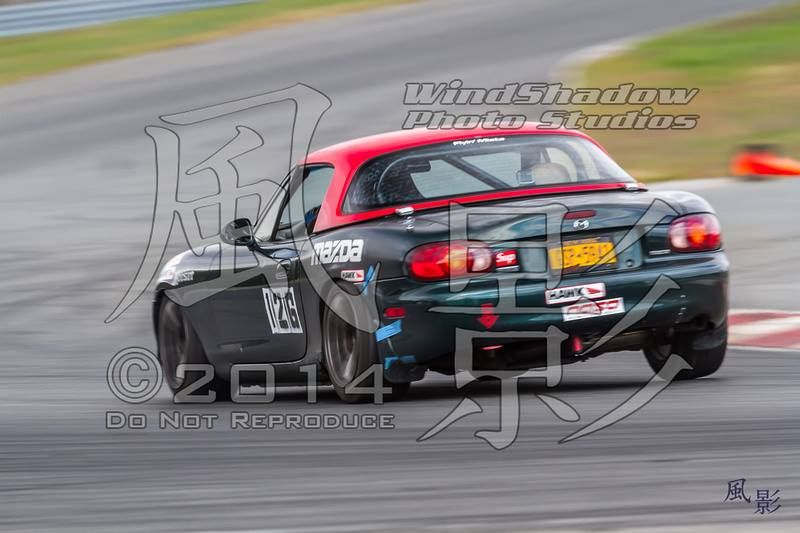Who is not running helper spings
#3
Joined: Apr 2014
Posts: 18,642
Total Cats: 1,866
From: Beaverton, USA
The Xida, being a long stroke damper, requires dual springs to make full use of the extra stroke available.
Spring stroke vs suspension articulation
A 2000 lb car with the motion ratio of just under 1.5:1 won't compress a short 700# spring far enough to allow meaningful droop travel with long stroke damper. To get the correct ride height, one must lower the preload collar until the springs have 25-60mm of free play. Without the secondary springs (helper), there is no spring stroke left to push the tire down to remain in contact with the road.
Weight
To get the correct spring rate for competition and high performance use while retaining enough spring stroke, would require a 9-11" long spring. Springs aren't light, particularly less expensive springs so that isn't a good solution. Hyperco and Swift generally have the lightest and most consistent rate springs on the market. We use Hyperco's because they cost about the same as Swifts and many of the sizes utilize their proprietary OBD (Optimum Body Diameter) design technology which further reduces weight and helps control distortion under compression.
Progressive rate
Beyond the spring weight issue, the Miata doesn't need 400-800lb springs when at full extension as the contact patch loading is almost nil then. A much lower rate will work better with that lightly loaded tire. What is called for is a progressive rate spring. Look at any purpose built race car that has more than about 75mm of damper stroke and you'll see dual springs. Off road and rally cars will often use three separate springs stacked up for a huge spring rate range.
Costs
If you start with the higher rate single spring setup then upgrade to duals later, the main springs may have to be swapped for a shorter set at the cost of about $150/pair. We offer the Xida Club Sport without the helpers for the Miata owner on a tight budget. The system will do everything better with the dual springs in place though. We tested the single spring Club Sports on our local bumpy road course on a Spec Miata with 9" wheels. They worked very well. Well enough for me to be comfortable offering the XCS without the helpers. Guys have been adding high spring rate Ground Control and other coilover sleeves to their Bilsteins and Koni Sports forever with good results so it's not like it doesn't work at all. It's just less than optimum. "Less that optimum" wasn't in the design criteria for the Xida's .
.
Without Helpers. Note the spring dangling free at full droop. Next image shows dual setup with coupler and Torrington bearings
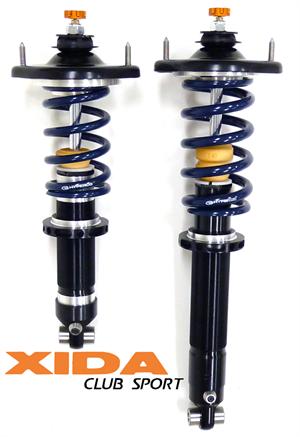
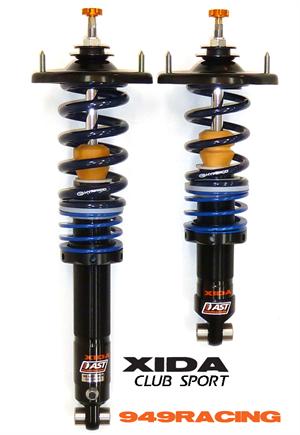
Spring stroke vs suspension articulation
A 2000 lb car with the motion ratio of just under 1.5:1 won't compress a short 700# spring far enough to allow meaningful droop travel with long stroke damper. To get the correct ride height, one must lower the preload collar until the springs have 25-60mm of free play. Without the secondary springs (helper), there is no spring stroke left to push the tire down to remain in contact with the road.
Weight
To get the correct spring rate for competition and high performance use while retaining enough spring stroke, would require a 9-11" long spring. Springs aren't light, particularly less expensive springs so that isn't a good solution. Hyperco and Swift generally have the lightest and most consistent rate springs on the market. We use Hyperco's because they cost about the same as Swifts and many of the sizes utilize their proprietary OBD (Optimum Body Diameter) design technology which further reduces weight and helps control distortion under compression.
Progressive rate
Beyond the spring weight issue, the Miata doesn't need 400-800lb springs when at full extension as the contact patch loading is almost nil then. A much lower rate will work better with that lightly loaded tire. What is called for is a progressive rate spring. Look at any purpose built race car that has more than about 75mm of damper stroke and you'll see dual springs. Off road and rally cars will often use three separate springs stacked up for a huge spring rate range.
Costs
If you start with the higher rate single spring setup then upgrade to duals later, the main springs may have to be swapped for a shorter set at the cost of about $150/pair. We offer the Xida Club Sport without the helpers for the Miata owner on a tight budget. The system will do everything better with the dual springs in place though. We tested the single spring Club Sports on our local bumpy road course on a Spec Miata with 9" wheels. They worked very well. Well enough for me to be comfortable offering the XCS without the helpers. Guys have been adding high spring rate Ground Control and other coilover sleeves to their Bilsteins and Koni Sports forever with good results so it's not like it doesn't work at all. It's just less than optimum. "Less that optimum" wasn't in the design criteria for the Xida's
 .
. Without Helpers. Note the spring dangling free at full droop. Next image shows dual setup with coupler and Torrington bearings


#6
No helpers on my 01, and the rears have too much play in the springs and they come unseated with droop. I think that the car would be faster with helpers (not to mention the unseated springs dicked up the threaded collars), so it's on the list of improvements when the Exocet chassis is swapped on. If it's in the budget, get the helpers.
#8
I've driven XIDAs with and without helpers. The car is better over curbs and large pavement undulations with the helpers. If you're spending the money, spend the extra and do it right.
#9
Joined: Apr 2014
Posts: 18,642
Total Cats: 1,866
From: Beaverton, USA
This should have been posted a long time ago.
Originally Posted by emilio700
Xida, being a long stroke damper, requires dual springs to make full use of the extra stroke available.
Spring stroke vs suspension articulation
A 2000 lb car with the motion ratio of just under 1.5:1 won't compress a short 700# spring far enough to allow meaningful droop travel with long stroke damper. To get the correct ride height, one must lower the preload collar until the springs have 25-60mm of free play. Without the secondary springs (helper), there is no spring stroke left to push the tire down to remain in contact with the road.
Weight
To get the correct spring rate for competition and high performance use while retaining enough spring stroke, would require a 9-11" long spring. Springs aren't light, particularly less expensive springs so that isn't a good solution. Hyperco and Swift generally have the lightest and most consistent rate springs on the market. We use Hyperco's because they cost about the same as Swifts and many of the sizes utilize their proprietary OBD (Optimum Body Diameter) design technology which further reduces weight and helps control distortion under compression.
Progressive rate
Beyond the spring weight issue, the Miata doesn't need 400-800lb springs when at full extension as the contact patch loading is almost nil then. A much lower rate will work better with that lightly loaded tire. What is called for is a progressive rate spring. Look at any purpose built race car that has more than about 75mm of damper stroke and you'll see dual springs. Off road and rally cars will often use three separate springs stacked up for a huge spring rate range.
Costs
If you start with the higher rate single spring setup then upgrade to duals later, the main springs may have to be swapped for a shorter set at the cost of about $150/pair. We offer the Xida Club Sport without the helpers for the Miata owner on a tight budget. The system will do everything better with the dual springs in place though. We tested the single spring Club Sports on our local bumpy road course on a Spec Miata with 9" wheels. They worked very well. Well enough for me to be comfortable offering the XCS without the helpers. Guys have been adding high spring rate Ground Control and other coilover sleeves to their Bilsteins and Koni Sports forever with good results so it's not like it doesn't work at all. It's just less than optimum. "Less that optimum" wasn't in the design criteria for the Xida's .
.
Without Helpers. Note the spring dangling free at full droop. Next image shows dual setup with coupler and Torrington bearings
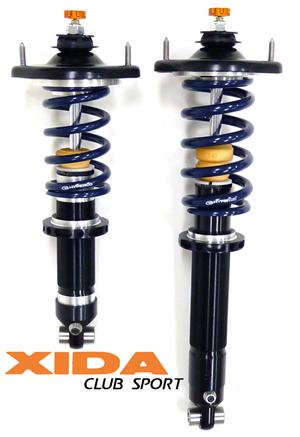
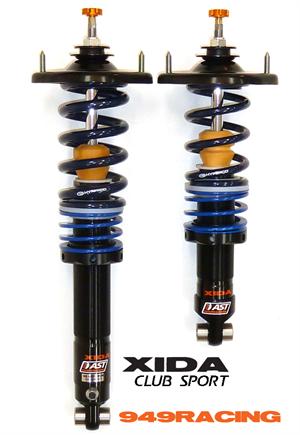
Spring stroke vs suspension articulation
A 2000 lb car with the motion ratio of just under 1.5:1 won't compress a short 700# spring far enough to allow meaningful droop travel with long stroke damper. To get the correct ride height, one must lower the preload collar until the springs have 25-60mm of free play. Without the secondary springs (helper), there is no spring stroke left to push the tire down to remain in contact with the road.
Weight
To get the correct spring rate for competition and high performance use while retaining enough spring stroke, would require a 9-11" long spring. Springs aren't light, particularly less expensive springs so that isn't a good solution. Hyperco and Swift generally have the lightest and most consistent rate springs on the market. We use Hyperco's because they cost about the same as Swifts and many of the sizes utilize their proprietary OBD (Optimum Body Diameter) design technology which further reduces weight and helps control distortion under compression.
Progressive rate
Beyond the spring weight issue, the Miata doesn't need 400-800lb springs when at full extension as the contact patch loading is almost nil then. A much lower rate will work better with that lightly loaded tire. What is called for is a progressive rate spring. Look at any purpose built race car that has more than about 75mm of damper stroke and you'll see dual springs. Off road and rally cars will often use three separate springs stacked up for a huge spring rate range.
Costs
If you start with the higher rate single spring setup then upgrade to duals later, the main springs may have to be swapped for a shorter set at the cost of about $150/pair. We offer the Xida Club Sport without the helpers for the Miata owner on a tight budget. The system will do everything better with the dual springs in place though. We tested the single spring Club Sports on our local bumpy road course on a Spec Miata with 9" wheels. They worked very well. Well enough for me to be comfortable offering the XCS without the helpers. Guys have been adding high spring rate Ground Control and other coilover sleeves to their Bilsteins and Koni Sports forever with good results so it's not like it doesn't work at all. It's just less than optimum. "Less that optimum" wasn't in the design criteria for the Xida's
 .
. Without Helpers. Note the spring dangling free at full droop. Next image shows dual setup with coupler and Torrington bearings


#11
The only videos I've ever found on youtube/vimeo were guys driving down the street, which of course they'll stay fully compressed under those conditions. I wouldn't expect them to start working until max cornering loads and over mid corner bumps. I reckon even fully compressed it could still be doing work though. The main spring could JUST be going slack and thereby doing nothing, while the helper still looks fully compressed, but is applying that 200lbs or whatever rate it is.
#16
So this video has me confused, again I have no idea of the drivers abilities, or the ride height. During a quick stop watch he is on for the spec miata record on rs-3 tires so likely a bit off pace but in the name of turning I chose this video. But at no time in this video did the helper make any moves. At rest it appears that there is double the bump stop in available stroke. Same as most that I've seen in other videos. Autox is about quick fast transitions which would make a different case than a track car.
#17
So this video has me confused, again I have no idea of the drivers abilities, or the ride height. During a quick stop watch he is on for the spec miata record on rs-3 tires so likely a bit off pace but in the name of turning I chose this video. But at no time in this video did the helper make any moves. At rest it appears that there is double the bump stop in available stroke. Same as most that I've seen in other videos. Autox is about quick fast transitions which would make a different case than a track car.
__________________
#19
But why not just run a longer spring to begin with. Helpers dont sit flat/true, and are a general annoyance to adjust around. What benefit does a 5.5" spring and helper give the end user over a 7" spring of the same rate.
#20
Joined: Apr 2014
Posts: 18,642
Total Cats: 1,866
From: Beaverton, USA
Why not use a longer main spring. I have helpers on the rear, and none on the front, because I cant run my fronts into droop beyond the spring limits and the helper in that case (as with most installed cases) ends up just a stupid stacked spacer. Just because the shocks will droop x far doesnt mean the suspension on the given car will, especially in the case of miata front end.
But why not just run a longer spring to begin with. Helpers dont sit flat/true, and are a general annoyance to adjust around. What benefit does a 5.5" spring and helper give the end user over a 7" spring of the same rate.
But why not just run a longer spring to begin with. Helpers dont sit flat/true, and are a general annoyance to adjust around. What benefit does a 5.5" spring and helper give the end user over a 7" spring of the same rate.



